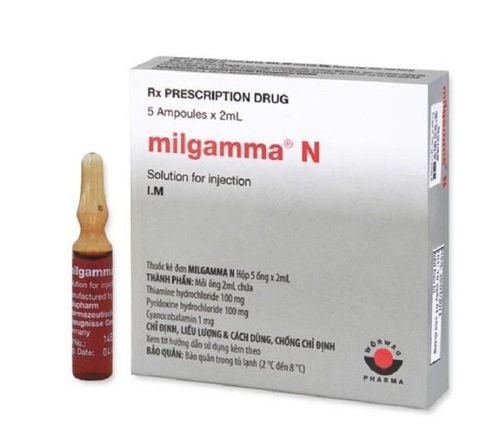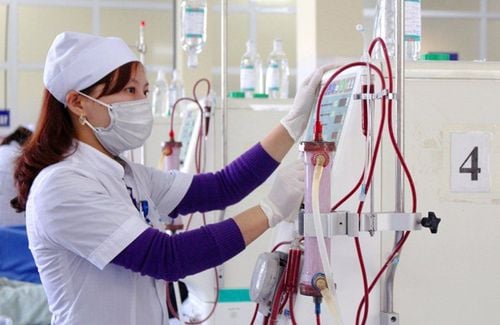This is an automatically translated article.
Guillain-Barre syndrome is a rare disease that causes many dangerous complications for patients if not treated promptly. Currently, the treatment of Guillain Barre syndrome usually uses the method of plasma exchange with 5% albumin replacement fluid with the aim of eliminating the autoimmune antibodies of this syndrome.1. Things to know about Guillain Barre syndrome
Guillain-Barre syndrome, also known as acute polyneuropathy, is an extremely rare syndrome caused by the immune system attacking the body's nerves.Currently there is no scientific study to indicate the cause of this disease, usually before this syndrome, patients often have an infectious disease such as a respiratory or stomach infection. However, as mentioned above, Guillain-Barre syndrome is very rare with 1-2 cases in every 100,000 people.
The initial symptoms of Guillain Barre syndrome are usually not noticeable to the patient, usually weakness, loss of sensation starting in the legs and feet and then spreading to the upper body and arms. Early symptoms can also stem from the arms or even on the face, weak muscles can develop into paralysis. In addition, people with Guillain Barre syndrome also have difficulty moving the face, speaking, chewing and swallowing, feel severe pain in the back, have difficulty controlling bladder or bowel functions, breathing, rhythm slow heart rate and low blood pressure.
Guillain-Barre syndrome is a serious disease and rapid disease development, when patients notice the initial signs, they should immediately be hospitalized for treatment support from a specialist. Early treatment of Guillain Barre syndrome helps patients avoid complications such as shortness of breath, sequelae of loss of sensation or paresthesias, cardiovascular problems, severe neuropathic pain, and dysfunction. bladder,...
Currently, there is no method to definitively treat Guillain Barre syndrome, however, treating Guillain Barre syndrome by plasma exchange or immunotherapy are two common methods doctors use. indicated for use with the aim of speeding up recovery and reducing the severity of the disease.
2. What is plasma exchange?

Thay huyết tương là liệu pháp thay thế huyết tương từ máu của bệnh nhân và thay thế vào một loại huyết tương mới đã được xử lý
To perform In plasma exchange, the doctor uses a machine similar to a hemodialysis machine, which can help separate the plasma from the blood, and the blood cells are re-transfused into the human body.
The plasma exchange method has many advantages in disease treatment such as a high success rate of up to 95%, improving the patient's medical condition quickly and effectively, helping the patient recover quickly after treatment. treatment process. Plasma exchange is in the support list of health insurance, so patients do not have to worry too much about the cost of treatment. Although this method has many advantages worth mentioning, it still has a disadvantage that the patient may have anaphylaxis, so during the plasma exchange, the doctor must pay attention to monitor the patient's situation. and stop treatment if there are abnormal symptoms.
3. Plasma exchange procedure in the treatment of Guillain Barre syndrome

Các trường hợp bệnh nhân bị hạ huyết áp cần điều trị huyết áp ổn định cho bệnh nhân rồi mới thực hiện thay huyết tương
Steps to perform plasma exchange in the treatment of Guillain Barre Step 1: Insert an intravenous catheter
Step 2: Set up the extracorporeal circulation, turn on the power to the machine and select the appropriate treatment method, install a filter Separate plasma and leads as directed. Use 0.9% sodium chloride solution mixed with heparin 5000UI / 1000ml to expel gas in the filter membrane and wires, then check the safety of the system.
Step 3: After connecting the blood line with the extracorporeal circulation, open the blood pump at a rate of 60-70 ml/min. The initial dose of heparin is 20 units/kg, then heparin is maintained at 10 units/kg every hour. When the blood volume reaches 1/3 of the filter, stop pumping blood and connect the extracorporeal circulation with the venous line and increase the blood rate to 100-120ml/min.
Step 4: Set the parameters for the machine to operate such as blood flow 100-200 ml/min, heparin dosage as mentioned above, plasma flow to be removed 20ml/min, warm albumin replacement fluid 5 % at 37 degrees C.
Step 5: Clean plasma exchange equipment after done.
Autoimmune peripheral neuropathy is a dangerous and rapidly progressive disease. As soon as you have symptoms of the disease, you should immediately go to reputable medical facilities for examination and treatment.
Please dial HOTLINE for more information or register for an appointment HERE. Download MyVinmec app to make appointments faster and to manage your bookings easily.













